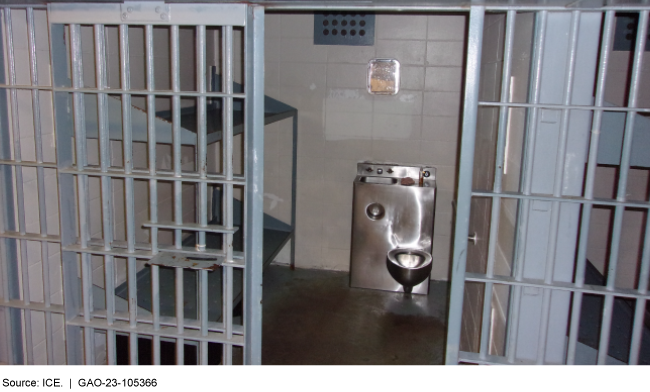Restrictive Housing: Actions Needed to Enhance BOP and ICE Management and Oversight
Fast Facts
We testified about our prior work related to use of restrictive housing, formerly referred to as "solitary confinement," in federal prison and detention facilities. In some cases, this includes isolating 1-2 people in cells for nearly 24 hours per day.
The Bureau of Prisons uses restrictive housing for about 8% of its prison population each year—about 11,000 people in FY 2023.
U.S. Immigration and Customs Enforcement recorded almost 15,000 restrictive housing placements in its detention facilities from FYs 2017-2021.
We have made recommendations to both agencies to improve their oversight of restrictive housing use.
Example of a Restrictive Housing Cell in an ICE Facility

Highlights
What GAO Found
Federal correctional and immigration detention facilities can place individuals in restrictive housing settings in certain circumstances. Restrictive housing generally consists of one- or two-person cells that isolate individuals from the general population. U.S. Immigration and Customs Enforcement (ICE) and the Bureau of Prisons (BOP) have policies and processes that govern their use of restrictive housing. Two prior studies examined restrictive housing at BOP, both of which identified ways for BOP to improve oversight. The first was a 2014 contracted assessment and the second was a 2016 Department of Justice report.
In February 2024, GAO reported that BOP had not fully implemented 54 of 87 recommendations from these two studies. BOP had fully implemented 33, partially addressed 42, and had not taken any steps to address the remaining 12 recommendations. This was due in part to BOP not assigning responsibility for recommendation implementation to appropriate officials and not establishing a time frame for completion. GAO recommended that BOP develop and execute an approach to fully implement recommendations from these prior studies. This would include assigning implementation responsibility, establishing a time frame for completion, and monitoring progress. BOP concurred and described its planned steps.
BOP and ICE have not consistently collected or used information needed for restrictive housing oversight. In reports from 2020–2024, GAO recommended actions to improve both BOP's processes for monitoring restrictive housing operations and BOP and ICE's analysis of complaints data. For example:
- In February 2024, GAO found that BOP was not monitoring key aspects of restrictive housing operations. Specifically, it did not examine the cause behind substantial racial disparity in a restrictive housing unit designed for individuals with heightened security concerns. GAO recommended that BOP conduct an evaluation to determine and address the cause of the racial disparity. BOP concurred and as of February 2024, said it would take steps to implement it.
- In August 2020 and February 2024, GAO found that neither ICE nor BOP was analyzing complaint data from those in its custody to identify areas for improvement, such as concerns over restrictive housing conditions. GAO made recommendations to ICE and BOP to analyze complaint data, which could help each agency identify trends and ultimately enhance oversight. As of December 2023, ICE has taken some steps, including integrating several data systems that store detention-related information into a new system to provide enhanced analysis capabilities. As of February 2024, BOP agreed to take steps toward implementation.
Why GAO Did This Study
ICE recorded 14,581 restrictive housing placements of detained noncitizens from fiscal years 2017 through 2021. Those placements increased by 18 percent from fiscal year 2017 to 2020 before declining in 2021. As of October 2023, BOP housed about 8 percent of all incarcerated individuals (approximately 11,600) in restrictive housing. Studies have shown some potentially harmful mental and physical impacts of such placements.
This statement discusses the extent to which (1) BOP has addressed recommendations from two prior restrictive housing studies and (2) BOP and ICE have information needed to manage and oversee use of restrictive housing.
This statement is based on three prior GAO reports published from August 2020 through February 2024, along with selected updates on ICE efforts to address previous GAO recommendations. To produce those reports, GAO reviewed ICE and BOP documentation, analyzed data, and interviewed agency officials. For selected recommendation updates, GAO reviewed documents and interviewed ICE officials.
Recommendations
GAO made eight recommendations to BOP and four recommendations to ICE that relate to restrictive housing in the reports covered by this statement. Although BOP and ICE agreed with the recommendations, as of April 2024 none of the 12 have been fully implemented. GAO will continue to monitor the agencies' implementation status.
